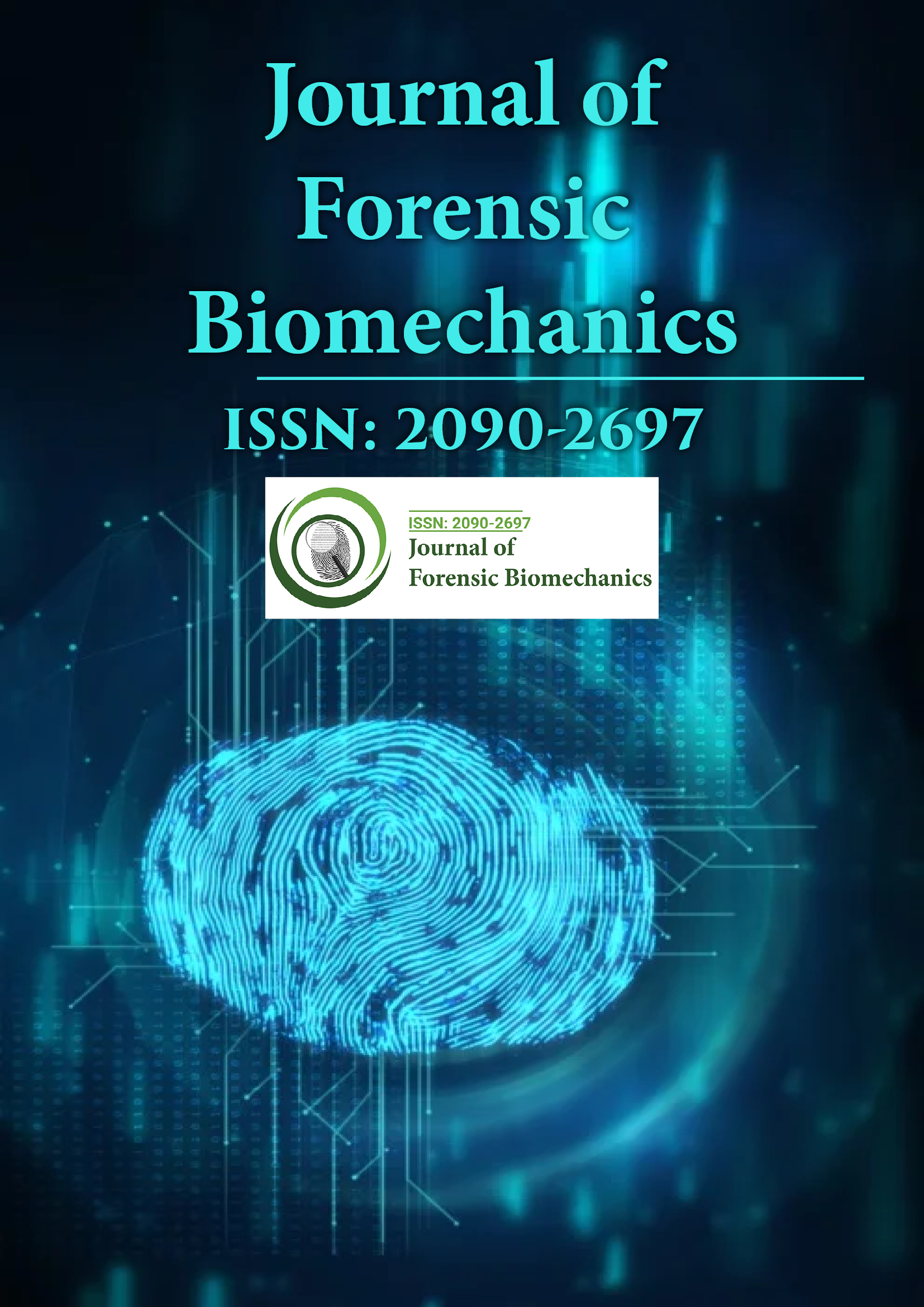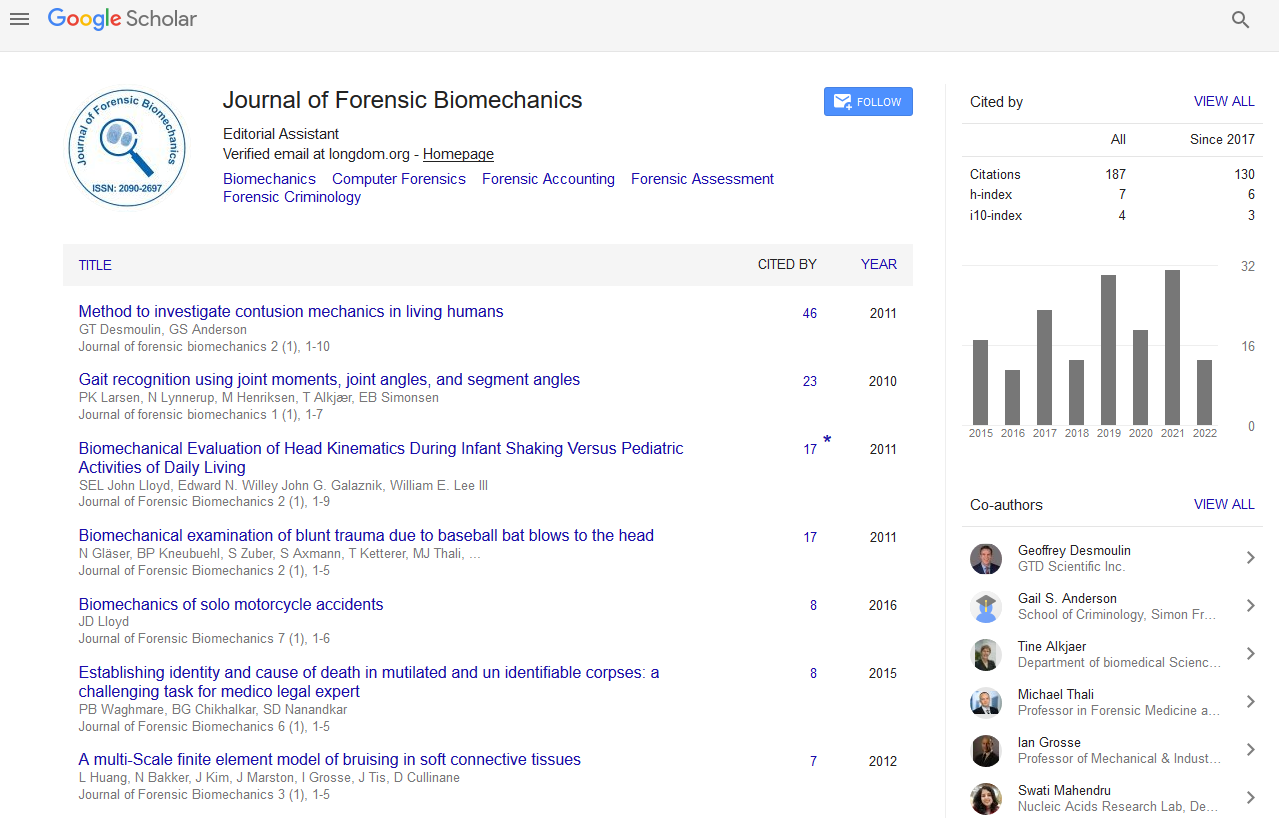Indexed In
- Genamics JournalSeek
- SafetyLit
- Ulrich's Periodicals Directory
- RefSeek
- Hamdard University
- EBSCO A-Z
- Geneva Foundation for Medical Education and Research
- Euro Pub
- Google Scholar
Useful Links
Share This Page
Journal Flyer

Open Access Journals
- Agri and Aquaculture
- Biochemistry
- Bioinformatics & Systems Biology
- Business & Management
- Chemistry
- Clinical Sciences
- Engineering
- Food & Nutrition
- General Science
- Genetics & Molecular Biology
- Immunology & Microbiology
- Medical Sciences
- Neuroscience & Psychology
- Nursing & Health Care
- Pharmaceutical Sciences
Commentary - (2025) Volume 16, Issue 1
Forensic Gait Analysis: Using Biomechanics to Identify Suspects
Seuss Steel*Received: 01-Jan-2025, Manuscript No. JFB-25-28532 ; Editor assigned: 03-Jan-2025, Pre QC No. JFB-25-28532 (PQ); Reviewed: 17-Jan-2025, QC No. JFB-25-28532 ; Revised: 24-Jan-2025, Manuscript No. JFB-25-28532 (R); Published: 31-Jan-2025, DOI: 10.35248/2090-2697.25.16.512
Description
Forensic gait analysis is a specialized branch of forensic biomechanics that focuses on studying human walking patterns to identify individuals involved in crimes. Every person has a unique way of walking, influenced by their anatomy, muscle coordination, joint flexibility, and even past injuries. By analyzing gait characteristics, forensic experts can compare surveillance footage, footprints, and movement patterns to link a suspect to a crime scene. This method has gained significant recognition in forensic science, particularly in cases where facial recognition or fingerprint evidence is absent. Gait analysis is based on the principle that human locomotion, or walking, follows a repetitive and distinctive pattern. The way a person moves is influenced by multiple factors, including limb proportions, joint mechanics, posture, and habitual movements.
These elements combine to create a unique biomechanical signature that can be captured and analyzed using video recordings, pressure-sensitive footprints, and motion analysis systems. Unlike fingerprints or DNA, which require physical contact, gait analysis can be performed remotely using security camera footage, making it a valuable tool in modern forensic investigations. One of the primary applications of forensic gait analysis is suspect identification from surveillance footage. Many crimes, including theft, assault, and even homicide, are recorded by CCTV cameras. However, in some cases, the footage quality is too poor to capture clear facial features, or the suspect may be wearing a mask. In such situations, investigators turn to gait analysis to study the suspect's movement patterns, comparing them to known individuals. Experts assess factors such as stride length, step frequency, foot angle, arm swing, and weight distribution to establish a match. These gait characteristics remain relatively stable over time, making them useful for longterm identification. In criminal cases, forensic gait analysis has been successfully used to provide supporting evidence. One notable example involved a burglary where the suspect’s face was not visible, but their distinctive limp and uneven step pattern were captured on surveillance video. Investigators compared the footage to the walking style of a known suspect, ultimately leading to their conviction. Similarly, in cases involving hit-andrun incidents, the gait of a fleeing suspect recorded by a nearby camera can help identify the driver responsible. Legal admissibility of gait analysis evidence also varies across jurisdictions. While some courts accept gait analysis as a valid forensic technique, others require additional scientific validation. Expert testimony plays an essential role in explaining the reliability and limitations of gait analysis to judges and juries. Properly conducted studies and peer-reviewed research have supported the credibility of gait analysis in forensic investigations, but on-going advancements are needed to enhance its accuracy and acceptance in the legal system.
In forensic science, the ability to identify suspects based on movement is an invaluable asset. As technology continues to evolve, forensic gait analysis will become more sophisticated, integrating AI-driven recognition systems and enhanced video analysis tools. The growing database of known gait patterns may further improve the effectiveness of this technique in criminal investigations. The future of forensic gait analysis holds great potential in solving crimes where traditional evidence is insufficient. By combining biomechanics, video technology, and artificial intelligence, forensic experts can establish new methods of identifying criminals based on movement alone. As research continues to refine gait recognition techniques, its role in law enforcement and justice will become even more significant, making it a powerful tool in forensic investigations.
Citation: Steel S (2025). Forensic Gait Analysis: Using Biomechanics to Identify Suspects. J Forensic Biomech. 16:512.
Copyright: © 2025 Steel S. This is an open-access article distributed under the terms of the Creative Commons Attribution License, which permits unrestricted use, distribution, and reproduction in any medium, provided the original author and source are credited

